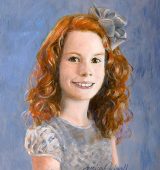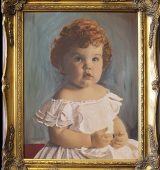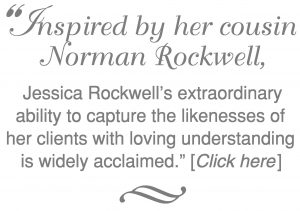Looking at my cousin Norman Rockwell’s recent 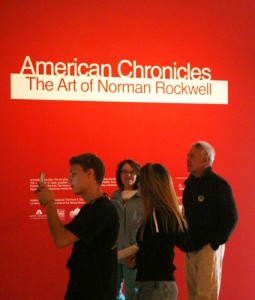 traveling exhibition brought me to contemplating how his brush strokes arrived on a canvas compared to how mine get there. The steps that we use are pretty different—at least on the surface. Most notably, he makes many successive pictures in charcoal and then paint before tackling the final canvas which contrasts to how I put all sketches and painting stages on the same canvas for my custom oil portraits.
traveling exhibition brought me to contemplating how his brush strokes arrived on a canvas compared to how mine get there. The steps that we use are pretty different—at least on the surface. Most notably, he makes many successive pictures in charcoal and then paint before tackling the final canvas which contrasts to how I put all sketches and painting stages on the same canvas for my custom oil portraits.
To illustrate, for his largest client, The Saturday Evening Post Magazine, for whom he made 323 covers over 47 years, the first thing he always did to start a new painting was to make a small thumbnail sketch of a man leaning on a lamppost. This was his tried and true method to discover the all-important idea that he would finally paint. Next he imagined what the guy could be doing or what was going on in the background. Say he envisions a thundercloud. He draws that in. As he gets more ideas, he draws out more thumbnails to show changes and additions until his single man leaning on a lamppost has morphed into an entire pictorial story he feels people will enjoy when they get their weekly magazine in the mail or when they buy it at a newsstand.
Next, he draws that out in a larger format. He then 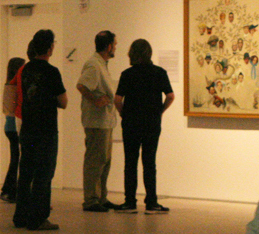 assembles model(s), costumes and props together with his faithful photographer. His large sketch is now a guide for all, as he directs the photo shoot, even to the extent of showing the model exactly how to pose and mimicking the precise facial expression that is needed. Indeed, his paintings are famous for the colorful emotions shown by his subjects.
assembles model(s), costumes and props together with his faithful photographer. His large sketch is now a guide for all, as he directs the photo shoot, even to the extent of showing the model exactly how to pose and mimicking the precise facial expression that is needed. Indeed, his paintings are famous for the colorful emotions shown by his subjects.
I also use photography to get my references. This can mean a photo shoot in our studio or at an out-of-town location, or clients can send me digital photos or prints. I am happy to advise on the best outfits for their portraits and make suggestions for suitable backgrounds. I too have a trusty photographer—that’s my husband who takes the photos while I direct. We then work with the client on the spot to choose the best ones. As with Cousin Norman, it’s customary that one photo is not perfect in all parts, and a separate close-up head and shoulder photo with the perfect expression is much easier to get, especially for children. For the background, if an outdoor scene is wanted, I photograph or find my references at a later date.
Norman would display all his photo prints on the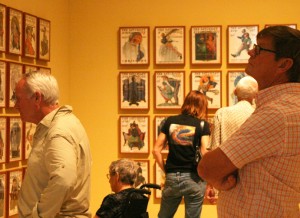 floor and choose which ones to use, projecting them onto paper the size of his ultimate canvas and drawing them out in charcoal. Once he had a finished charcoal composition, he would work out the colors in oil on a medium-sized canvas. Only then would he go to his final canvas, trace the charcoal composition onto it and paint it in, referring to the original photos for the many nuances that were his hallmark.
floor and choose which ones to use, projecting them onto paper the size of his ultimate canvas and drawing them out in charcoal. Once he had a finished charcoal composition, he would work out the colors in oil on a medium-sized canvas. Only then would he go to his final canvas, trace the charcoal composition onto it and paint it in, referring to the original photos for the many nuances that were his hallmark.
My photo references get printed in my husband’s digital lab. I too refer to them continually throughout the painting procedure. I draw out the subject onto canvas and then paint it in quickly the first day, sometimes with only brown and white paint at first, and sometimes in full color. On top of the resulting rough oil sketch, I make refinements over a few days until I am ready to start sketching the background in and bring it up to the same level of finish as the subject. Then I work both figure and background together: refining, refining, refining, always keeping the background more impressionistic than the figure. With skin tones I use transparent and translucent layers that show more depth as the light refracts through each layer slightly differently. I work to get the most details in the face, particularly the eyes and mouth, to show the wonderful likeness to the subject(s) that is the most important element about a great portrait.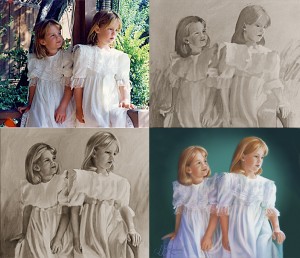
As I ended my visit with my cousin’s beloved paintings, I was thankful again for the inspiration he continues to give me. Once again, I enjoyed contemplating the painting procedures of Norman Rockwell, my cousin.
Would you like a portrait of yourself or a loved one? There’s no more Norman Rockwell around, but his legend enhances us all. If you like, you can still contact me to get your own beautiful painting done.
Related Posts:
• Portrait Oil Painting Technique Salutes Masters
• Norman Rockwell Traveling Exhibit Shows in Tampa
• My Cousin Norman Rockwell
• Norman Rockwell’s Legacy














